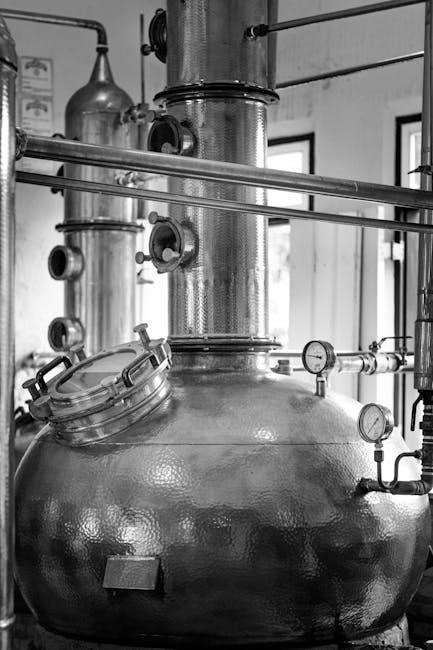Piping and Instrumentation Diagram (P&ID) Symbols: An Overview
Piping and Instrumentation Diagrams (P&IDs) employ specific symbols to illustrate the connectivity of equipment, sensors, and valves within a control system. These symbols, often standardized, represent actuators, sensors, and controllers. Understanding these symbols is vital for interpreting P&IDs, crucial for engineers and operators.
Definition and Purpose of P&ID Symbols
P&ID symbols are standardized notations and graphical representations utilized on Piping and Instrumentation Diagrams (P&IDs). They depict components and systems involved in process flows within a facility. These symbols are essential for engineers, operators, and workers to understand the layout, operation, and interconnections of the system. A P&ID serves as a schematic representation of the functional relationship between piping, instrumentation, and system equipment components.
The symbols within a P&ID are categorized to represent various aspects, including instruments, valves, pumps, line colors, connection types, piping, vessels, and heat exchangers. These shapes visually represent the functional relationships between piping, instrumentation, and system equipment units. They detail the connectivity of equipment, sensors, and valves in a control system, representing actuators, sensors, and controllers.
The purpose of P&ID symbols is multifaceted. They facilitate clear communication among various stakeholders involved in the design, construction, operation, and maintenance of a process plant. They provide a visual language for understanding complex systems, enabling efficient troubleshooting, and ensuring safety. The symbols are vital for improving collaboration among engineers and designers.
Ultimately, P&ID symbols are the cornerstone of a P&ID, allowing for the comprehensive and unambiguous representation of a process system’s intricate details.
Importance of Standardized Symbols
Standardized P&ID symbols are crucial for effective communication and understanding within the process industries. The use of a common, recognized set of symbols ensures that engineers, operators, and technicians can readily interpret P&IDs, regardless of their location or specific company affiliation. This standardization facilitates collaboration and reduces the potential for errors arising from misinterpretations of non-standard symbols.
Consistency in symbology enhances safety by providing a clear and unambiguous representation of the process system. In emergency situations, the ability to quickly and accurately understand a P&ID can be critical for taking appropriate action. Standardized symbols allow for rapid identification of key components, such as safety valves, emergency shutdown systems, and critical instrumentation.
Moreover, standardized symbols streamline training and documentation processes. Training programs can focus on a single set of symbols, reducing the learning curve and improving comprehension. Documentation, such as operating procedures and maintenance manuals, can be created using consistent symbology, ensuring clarity and ease of use.
In essence, standardized P&ID symbols are a cornerstone of efficient, safe, and reliable process operations. They promote clear communication, facilitate training, and improve overall understanding of complex process systems, ultimately contributing to improved performance and reduced risk.

Categories of P&ID Symbols
P&ID symbols are categorized to represent different components. Common categories include instrumentation, depicting sensors and controllers; piping, showing pipes and connections; and valves, indicating control mechanisms. These categories aid in quickly identifying components within a process system diagram, and improving comprehension.
Instrumentation Symbols
Instrumentation symbols on P&IDs represent the various sensors, transmitters, controllers, and other devices used to monitor and control process variables. These symbols are crucial for understanding how a system is automated and controlled. They illustrate the functional relationship between different components in a process system, aiding engineers and operators in visualizing and interpreting control strategies.
Common instrumentation symbols include those representing temperature sensors, pressure sensors, flow sensors, level sensors, and analytical instruments. Each type of sensor has a unique symbol, often depicted within a circle, with letters indicating the type of measurement and function performed. For example, a temperature transmitter might be represented by a circle with “TT” inside.
Controllers are also represented by specific symbols, often differentiated by their function (e.g., flow controller, pressure controller). These symbols indicate how the control system maintains desired process conditions. Understanding these symbols improves P&ID collaboration among engineers, designers, and operators. Standard ISA (Instrumentation, Systems, and Automation Society) practices often guide instrumentation symbology, promoting uniformity and clarity across different diagrams and facilities. Correct interpretation of these symbols is vital for effective system operation and troubleshooting.

The legend of a P&ID will always include a detailed explanation of each instrumentation symbol used. It’s essential to refer to this legend to accurately interpret the diagram and understand the control logic of the system.

Piping Symbols
Piping symbols on P&IDs represent the physical pipelines that transport fluids and gases within a process system. These symbols are fundamental for illustrating the layout and connectivity of the piping network, enabling engineers and operators to understand the flow paths of different substances.
Basic piping symbols include straight lines, which represent straight sections of pipe, and various symbols for pipe fittings such as elbows, tees, reducers, and flanges. Each fitting has a unique symbol that indicates its function in the piping system. For example, an elbow is typically represented by a curved line, while a tee is represented by a T-shaped symbol.
Different line types are also used to distinguish between different types of piping, such as process lines, utility lines, and drain lines. These line types may be indicated by different colors, thicknesses, or patterns. For example, a process line may be represented by a solid line, while a utility line may be represented by a dashed line. Understanding these line types is crucial for identifying the purpose of each pipe in the system.
Additionally, piping symbols may include annotations that indicate the pipe size, material, and schedule. This information is vital for ensuring that the piping system is designed and constructed correctly. The P&ID legend will provide a detailed explanation of each piping symbol and line type used in the diagram, facilitating accurate interpretation and collaboration.
Valve Symbols
Valve symbols in P&IDs are critical for representing the various types of valves used to control the flow of fluids and gases within a process system. These symbols are essential for understanding how the system operates and how flow can be regulated.
Common valve symbols include those for gate valves, globe valves, ball valves, check valves, and control valves. Each valve type has a distinct symbol that reflects its specific function and operating mechanism. For example, a gate valve is typically represented by a symbol that shows a sliding gate, while a globe valve is represented by a symbol that shows a disc moving perpendicular to the flow.
Control valves, which are used to automatically regulate flow, have more complex symbols that indicate the type of actuator used to control the valve position. These actuators can be pneumatic, hydraulic, or electric. The symbol will also often include information about the valve’s positioner and any associated instrumentation.
Furthermore, valve symbols may include annotations that specify the valve size, material, and pressure rating. This information is vital for ensuring that the correct valve is selected for each application. The P&ID legend is an indispensable tool for deciphering valve symbols, providing comprehensive details about each symbol’s meaning and function, thereby promoting accurate interpretation and effective communication among engineers and operators.

Reading and Understanding P&IDs
Reading P&IDs involves understanding the symbols representing equipment, sensors, and valves, showing system connectivity in a control system. Knowing symbology improves P&ID collaboration for engineers. Legends categorize symbols for instruments, valves, pumps, piping, vessels, and heat exchangers, aiding in accurate interpretation.
Interpreting Symbol Legends
Interpreting symbol legends is a cornerstone of effectively reading Piping and Instrumentation Diagrams (P&IDs). These legends serve as a comprehensive key, unlocking the meaning behind the various graphical representations used throughout the diagram. Typically, legends are organized into categories, each dedicated to a specific type of component or function within the system.
A common categorization includes instruments, valves, pumps, and piping. The legend clarifies the distinct symbols used for each instrument type, such as pressure transmitters, temperature sensors, and flow meters. Valve symbols are equally important, differentiating between gate valves, ball valves, control valves, and other valve types crucial for process control.
Furthermore, the legend will illustrate the symbols for various types of pumps, including centrifugal pumps, positive displacement pumps, and vacuum pumps. Understanding these pump symbols is essential for comprehending the fluid transfer mechanisms within the system. Piping symbols are also detailed, depicting different line types like process lines, utility lines, and instrument signal lines.
Beyond components, the legend also explains the symbols representing vessels, heat exchangers, and other specialized equipment. The shapes within the legend represent functional relationships, providing a visual guide to the interconnections between piping, instrumentation, and system equipment units, facilitating accurate comprehension of P&IDs.
Understanding System Connectivity
Understanding system connectivity within a Piping and Instrumentation Diagram (P&ID) is paramount to grasping the overall functionality of a process plant. P&IDs meticulously illustrate how various components—pipes, instruments, valves, and equipment—are interconnected to achieve a specific operational objective. Deciphering these connections requires a systematic approach, focusing on the flow paths and control loops depicted in the diagram.
The lines representing pipes indicate the physical pathways through which fluids and gases are transported. Different line types, often distinguished by varying line styles or colors, signify different services or functions, such as process lines, utility lines, or instrument signal lines. By tracing these lines, one can visualize the movement of materials throughout the system.
Instrumentation plays a crucial role in monitoring and controlling the process. Sensors, transmitters, and control valves are strategically placed within the system and connected through signal lines. Understanding how these instruments are linked and how they interact to maintain desired process parameters is key to comprehending the control strategy.
Valves, strategically positioned along the piping network, regulate the flow of materials. Identifying the valve types and their control mechanisms is vital for understanding how the process is started, stopped, or modulated. Furthermore, understanding the interdependencies between different sections of the system allows for effective troubleshooting and optimization of process operations, which is fundamental for efficient plant management.